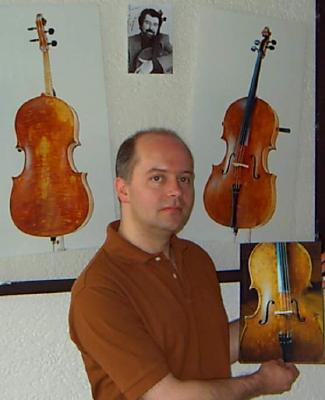|
<< -- 5 -- Tess Crebbin THE MIGHTY VENETIAN

Postscript:
A few Montagnana facts:
Life:
Dominico Montagnana was born on 27 June 1686 in Lendinara, Italy as the seventh son of a family with eight children. The other children were Lodovico the elder who survived not even one year (1682-1682), Lodovico the younger (1683-1758), Lorenzo (born 1678), Domenica (born 1673), Rosa (born 1669), Lorenzo the elder (1670-1678), Lorenzo the younger (born 1678), and Margarita (1692-1692).
His father, Paolo, was a shoemaker. They had their share of family heartbreak: Dominico grew up with some major personal losses: three of his siblings died (his brothers Lorenzo and Lodovico the elder, and his sister Margarita) and, when he was nine years old, he lost his mother Andriana Montagnana, nee Spinelli. It has been speculated that Domenico dealt with his grief by finding refuge in his art: the making of fine instruments. He established a workshop in the Calle degli Stagneri/SantoBartolomeo by 1712. He met a Venetian woman living in the district: Caterina Berti whom he married. The couple lived in Venice and had six daughters and no sons, something very unusual for the great instrument makers most of whom produced sons to pass their workshops on to. Their first daughter, Ludovica, was born in 1719, and Virginia followed one year later. Then came Domenica Antonia (born in 1722), followed by Anna (1724), Maria (1727) and Angela (1728). But all was not fine and well in the Montagnana household, where life kept being marred by tragedy: The couple lost daughter Lodovica at the age of 16, and in August of the same year Domenico's friend and neighbor August Anzello Sopran also died. Following the birth of their last child, Caterina began suffering from progressive paralysis, which eventually led to her death in 1748. It seems that this final blow was too much for Montagnana, who until then had been seeking refuge in his workshop and spending much longer time than usual on the meticulous details of his instruments. His health began to decline rapidly, of unspecified causes, and by February 1750 he was bedridden. His death certificate states that he died after being confined to his bed for one month with 'hypochondriac illness' although, in all fairness, the illness was hardly of hypochondriac nature if it killed him. He left behind an intriguing life story and a number of wonderful instruments, the meticulous workmanship of which speaks for themselves and the genius of their maker.

Many modern instrument makers now copy Montagnana cellos. Here, Bubenreuth-based Wolfgang Schnabl poses before a picture of Boris Pergamenschikow and his 1735 Montagnana cello. Schnabl holds up a photograph of an exact copy he made of this cello. To do so, he borrowed Pergamenschikow's cello to take its precise measurements and created a respective mould. Schnabl's Montagnana copies are considered to be among the best available on the market, also in terms of sound reproduction, and sell for around 20,000 euros. Photo © Philip Crebbin
|
Continue >>
Copyright © 7 March 2006
Tess Crebbin, Germany

|

